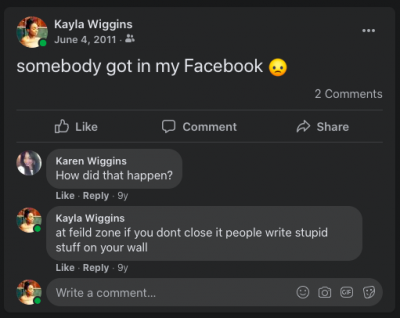Kayla Wiggins
I had low expectations for my online presence coming into this journey. Uncovering my data identity was like raiding a tomb that had already been picked clean ages ago, leaving nothing behind but unassuming bronze trinkets and dusty statues. There wasn’t much to see, and I think that fact has kept me shrouded in a healthy layer of anonymity.
To give my attitude about this journey into my data identity some context, I need to summarize my history with the internet. I had my own laptop and unregulated access to the web from a very young age; since I was about 10 years old to be precise. I remember a clunky Acer with a huge peace sign sticker on the front running nothing but early 2000’s MMORPGs and flash games. I had a Facebook, but it mostly existed to post updates from FarmVille and its alternatives. I had an Instagram but never really knew what to post on it. I was easily embarrassed back then so I think the idea of putting my face and thoughts on display for the whole world to scrutinize wasn’t worth the risk for me. In fact, I think it’s that aversion to embarrassment, and the idea that all my mistakes would be public if I let them is what turned me into such a private adult.
I’ve cleaned up my digital footprint a few times in the past. Firstly, as an assignment for an internet literacy class and later on my own to ensure I still had control over my digital persona. I knew almost exactly what information about me existed online before starting this journey and I find comfort in how little there is to be seen. My data identity is authentic because almost everything available online was put there by me. It’s stable because I control the flow of most new information. And finally, it’s incomplete by design. I believe an incomplete data identity is safest for someone like me who values privacy and embodies identities that would readily be taken advantage of by the algorithms that influence our daily lives.
Contents
Searching for Me
The first step in my data identity journey was searching my name in Google, Yahoo, and Bing. There are obviously plenty of people in this world that share my name and I don’t particularly want to be found so finding links that actually pertain to me takes a lot of work without including specific details in the search, like the university I attend.
Searching for ‘Kayla Wiggins’
Google is by far the best at finding my information based on a simple search for my name. It managed to pull up about one relevant result per page for the first five pages of results. My LinkedIn is the third result on page one. My Department of Anthropology Student Spotlight and my project folder for the class Animation for Non-Majors on Vimeo are the fifth and sixth results on page two. Pages three through five house my Medium profile, my first website on WordPress, and my resume on Github respectively. What few relevant links exist are scattered throughout Google’s results and other engines are even worse gathering information about me near the front page. This is discouraging for anyone trying to gather a comprehensive picture of me from my data identity. I knew which links were relevant in Google’s results but anyone else would be left confused as to which links held information about me or another Kayla Wiggins. As Safiya Noble points out in Algorithms of Oppression, “In general, search engine users are doing simple searches consisting of one or more natural-language terms submitted to Google; they typically do not conduct searches in a broad or deep manner but rather with a few keywords, nor are they often looking past the first page or so of search engine results, as a general rule.” I imagine most searchers curious about me would give up before getting a complete picture.
Searching for ‘Kayla Wiggins University of Michigan’
Searching for ‘Kayla Wiggins University of Michigan’ brings all my scattered information to the front page of Google’s search results. It even brings up some content hidden deep within the internet, like a Youtube video about my work in the University of Michigan’s Academic Innovation lab. There are other videos about me on the internet but I’ve made them unlisted. This more detailed search pulls up my old WordPress website first on other search engines which is not ideal because it’s incomplete and hasn’t been updated in years.
Search Results
As the face (so to speak) of my data identity I’m satisfied with the information available on Google, and to an extent, the other engines as well. I like the fact that you need to start with more than a name to get useful information to compile and what you do get is sparse, accurate, and produced by me. In other words, it’s stable, authentic, and incomplete. Based on these results you get the image of a young black woman majoring in Information at the University of Michigan. Boring, yes, but in my opinion having my race and gender exposed online are sacrificial enough without also disclosing details from my personal life like my political affiliations and opinions, social groups, buying habits, etc. Noble argues that “Because Black communities live in material conditions that are structured physically and spatially in the context of a freedom struggle for recognition and resources, the privately controlled Internet portals that function as a public space for making sense of the distribution of resources, including identity-based information, have to be interrogated thoroughly.” By maintaining a data identity that is largely nondescript I can attempt to avoid the technological racialization that might otherwise see me associated with negative stereotypes or boxed out of certain resources.
